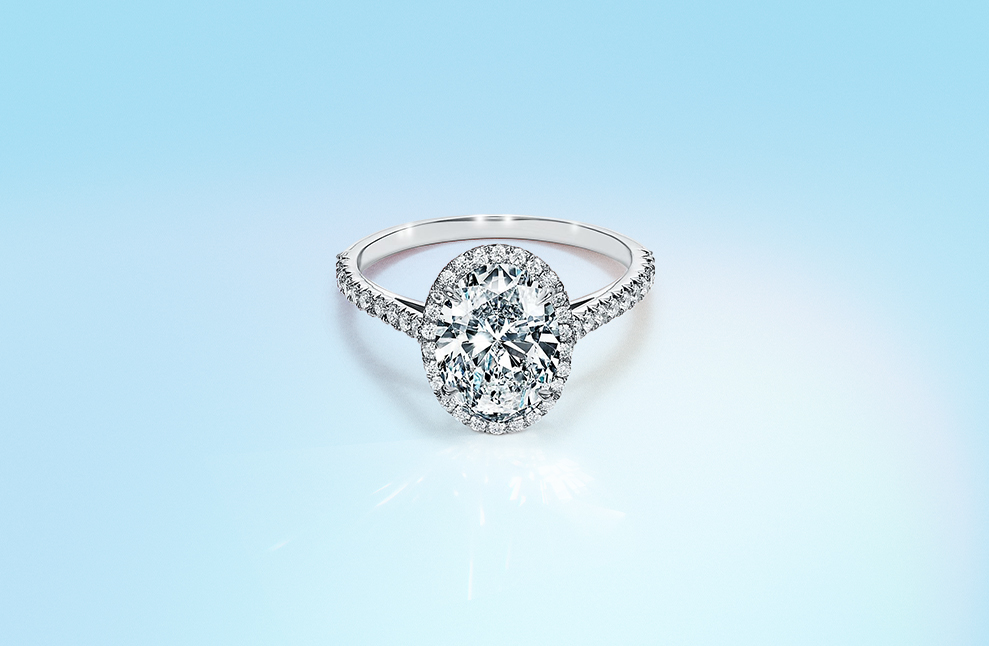How To Choose Lab Created Diamond Halo Engagement Ring
When a moment turns into a lifelong promise, the perfect engagement ring you choose becomes the tangible symbol of that shared journey. For countless couples, this symbol is a halo engagement ring, a design that has captured hearts for generations. It’s not just a ring; it’s a tiny constellation on your finger, where a central star is embraced by a radiant orbit of smaller diamonds. By pairing this beloved style with a lab diamond, you’re not only choosing a piece of jewelry but also making a conscious choice for brilliance, value, and a more thoughtful future. It’s a modern love story, told through light and sparkle.
In this blog post, we’re going to talk about how you can choose your perfect halo engagement ring from scratch, covering every detail, from halo prongs to halo types, from which diamond to select to which wedding band will complement your halo engagement ring perfectly. Everything will be covered, so don’t worry, and let’s get started!
What Is a Halo Engagement Ring?
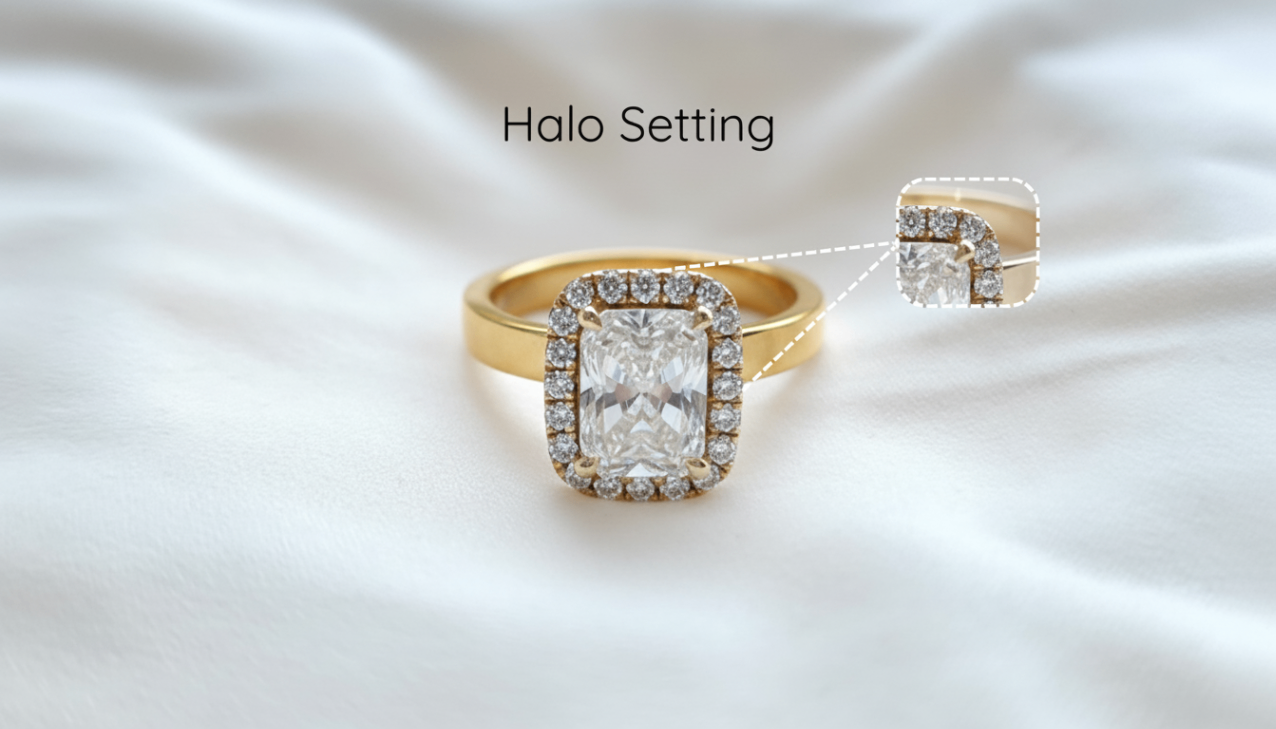
The halo diamond engagement ring, with its stunning circle of diamonds, is a design defined by its central diamond gracefully encircled by a band of smaller stones. The tiny diamonds encrusted in the halo are mostly melee diamonds.
This artistic arrangement has a powerful effect: it magnifies the center diamond, making it appear larger and more brilliant than its actual total carat weight. The result is a ring that radiates from every angle, creating a spectacular display of light and fire.
- History of the Halo: The halo setting has a rich and storied history, with its origins stretching back to the Georgian and Victorian eras of the 1700s and 1800s. It saw a major resurgence during the Art Deco period of the 1920s, with designers using the halo to create geometric, symmetrical masterpieces.
- Why It Endures: Its ability to maximize sparkle while adding vintage-meets-modern charm makes it a favorite.
What are the different Halo’s shapes you should know Before Buying?
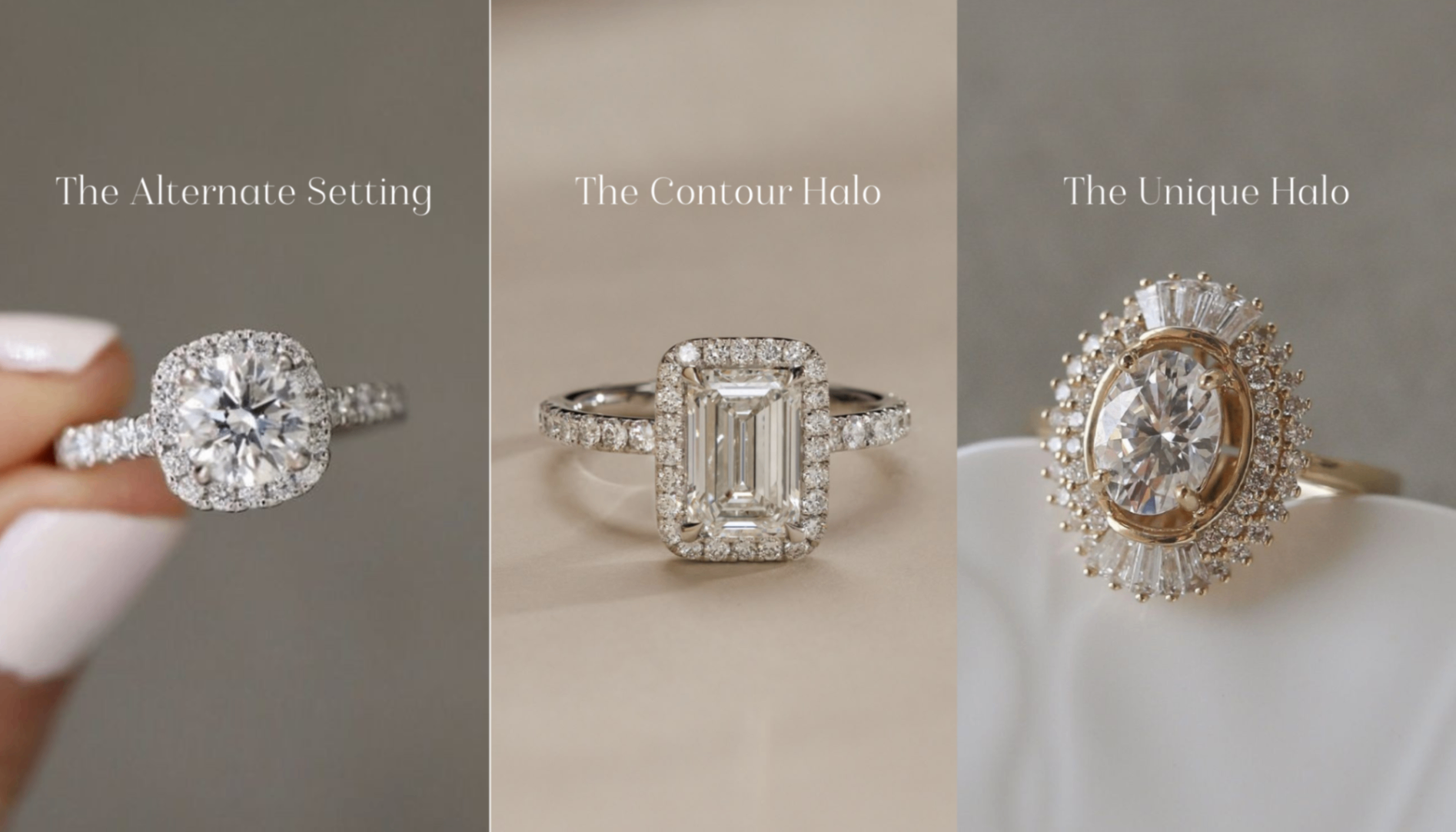
The halo ring itself can take different shapes, each adding to the overall sparkle and distinct personality of the ring.
The Alternate Setting
The alternate setting is a playful and unique option where the shape of the halo differs from the shape of the center stone. For example, a rectangular halo with an oval center diamond, or a square cushion halo surrounding a round stone. This creates an interesting and unexpected contrast. A clever trick with this setting is that the halo’s shape can make the center stone appear to be the same shape as the halo, creating a beautiful visual effect and a one-of-a-kind ring.
The Contour Halo
A contour halo is designed to follow the precise outline of the center stone, hugging it tightly and seamlessly. This style emphasizes the diamond’s natural shape, creating a clean, cohesive look that is both modern and elegant.
The Unique Halo
This category is for the true individualist. Unique halos feature creative, non-traditional outlines, such as floral motifs, geometric shapes, or free-flowing, asymmetrical designs. They are perfect for expressing a distinct personality and creating a truly custom piece.
Which Stone Size is Suitable for Your Halo?
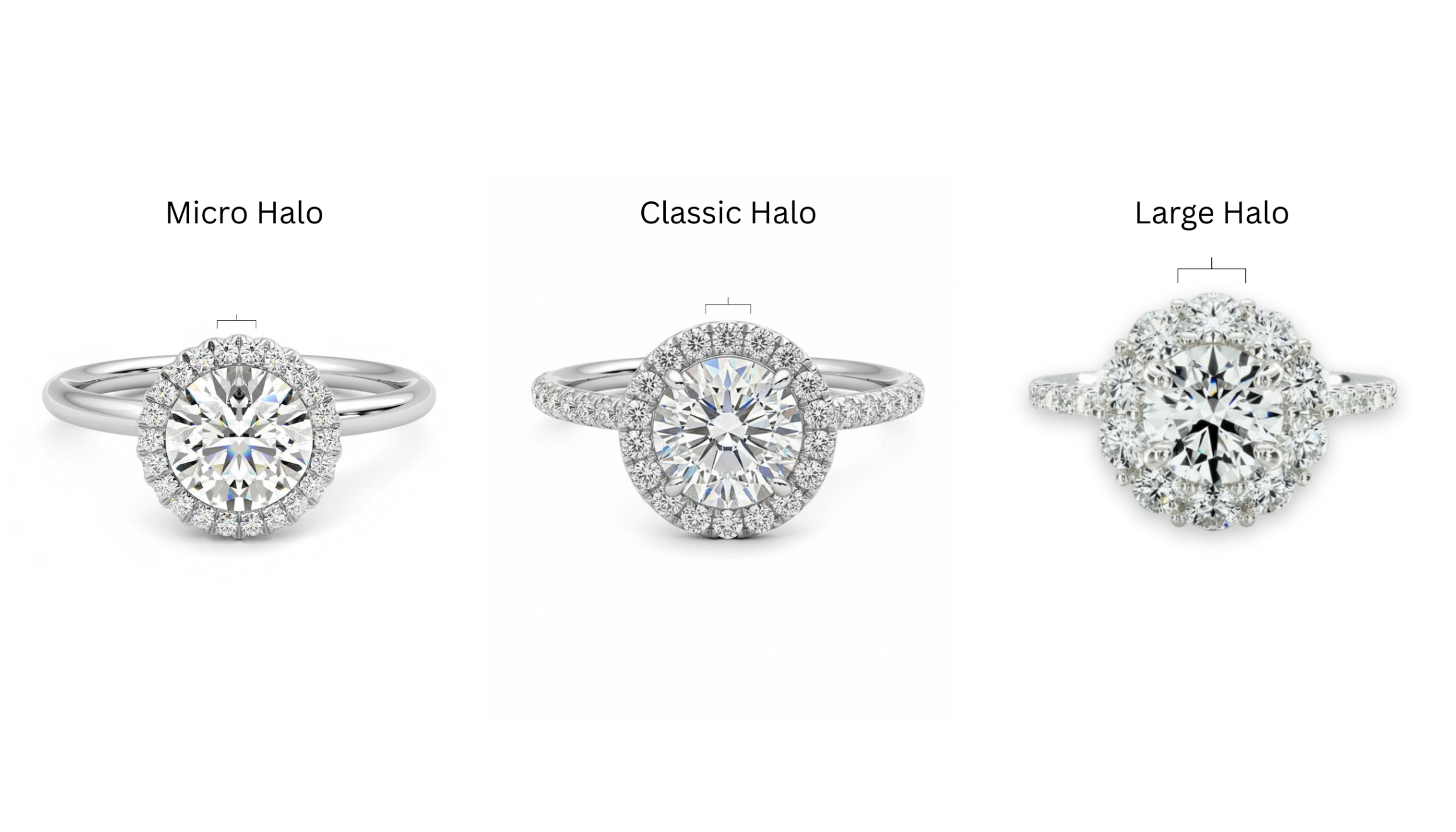
The size of the diamonds in your halo can dramatically change the ring’s overall aesthetic. Consider these options to find your perfect match:
- Micro Halo: A micro halo features very small diamonds set closely together, creating a delicate, almost ethereal shimmer. This subtle sparkle is perfect for someone who prefers a minimalist look, or for a petite hand where a larger halo might feel overwhelming. It enhances the center stone’s size without overpowering it.
- Classic Halo: The classic halo uses diamonds of a balanced, traditional size that provide a noticeable frame of light. This is the go-to choice for a reason; it offers a significant boost in visual size and sparkle, creating a timeless and elegant look that is beautiful on any hand.
- Large Halo: For maximum impact and glamour, a large halo features bigger diamonds that create a bold, dramatic statement. This style is for the person who wants their ring to be the center of attention. It is also an excellent choice for balancing the appearance of a larger or longer finger.
Types of Halo Engagement Rings
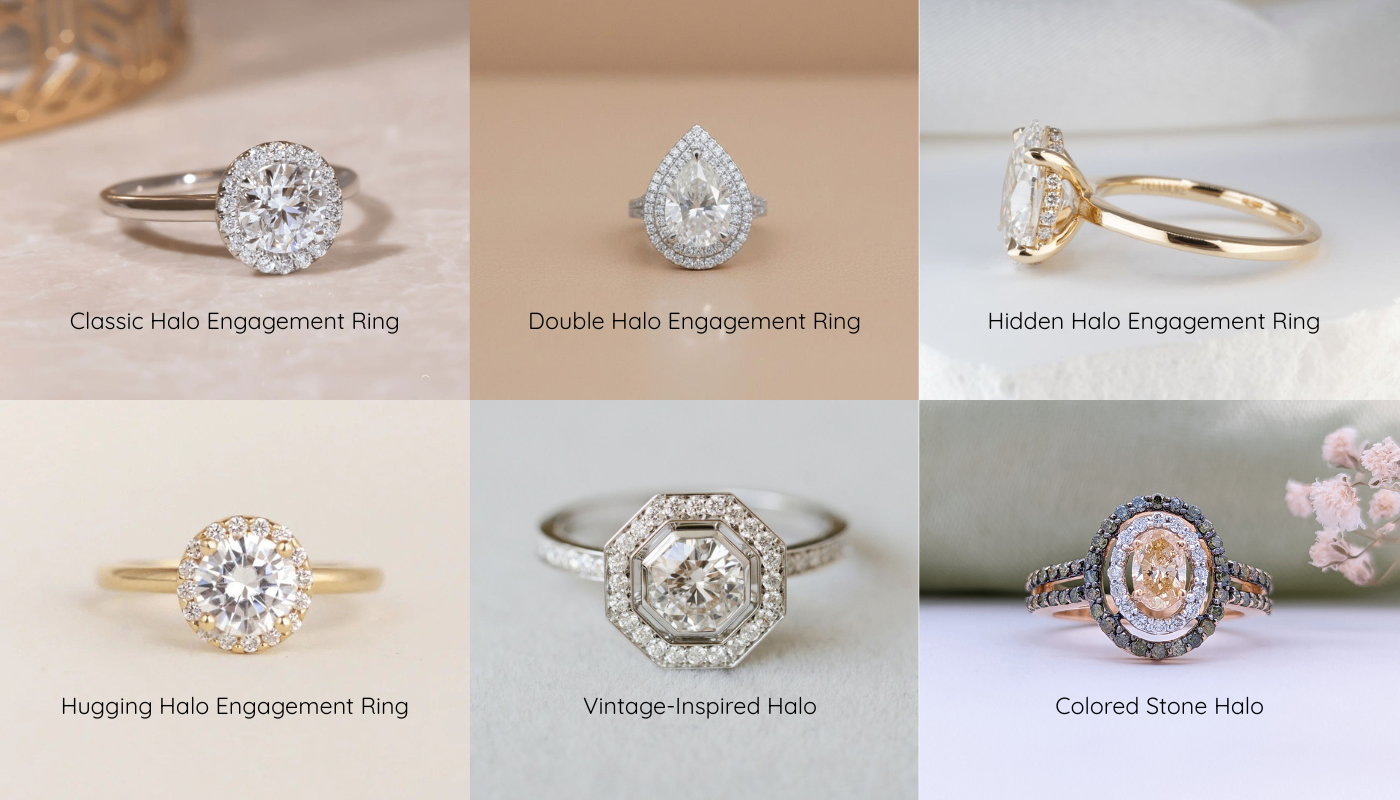
The halo’s design can be further refined into several distinct types, each offering a different aesthetic and level of sparkle.
Classic Halo Engagement Ring
The quintessential halo features a single, uninterrupted ring of diamonds that encircles the center stone. It’s simple, refined, and utterly timeless, a perfect choice for a person who wants to keep the ring a little simple but doesn’t want just a solitaire. A classic halo with a round or cushion diamond is just your basic, very easy to make, find, and go-to ring setting for engagements.
Double Halo Engagement Ring
For the person who believes more is more, the double halo offers an extra layer of brilliance with two concentric circles of diamonds. If you have long and chubby fingers, consider a double halo setting ring with elongated shapes, such as marquise, emerald, radiant, or elongated cushion, as it will help conceal the extra space on your finger and make it appear slimmer. This bold design maximizes sparkle and creates a powerful, glamorous statement.
Hidden Halo Engagement Ring
A hidden halo is a delightful secret, a subtle row of diamonds nestled just beneath the central stone. This design offers a gentle, private shimmer that is only fully revealed from the side, adding an element of surprise and intricate detail. This halo looks incredibly luxurious and beautiful, and will be the perfect match for a radiant cut diamond center stone. However, you can also choose an oval shape, a round brilliant, or an emerald-cut diamond; this hidden halo will definitely complement everything.
Hugging Halo Engagement Ring
A halo that tightly “hugs” the center diamond, blending seamlessly for a sleek, polished look. This is a streamlined, minimalist take on the halo. The diamonds are set so closely together and so near the center stone that the two elements seem to blend into a single, magnificent piece of light. It’s a sleek and sophisticated choice. This style is most commonly paired with a round brilliant, oval, or cushion cut diamond, as its softer, more rounded edges complement the seamless design.
Vintage-Inspired Halo
These rings pay homage to the past with milgrain detailing, delicate filigree, or a unique setting that recalls the elegance of the Victorian, Edwardian, or Art Deco eras. They are perfect for the old soul who values history and craftsmanship. Round, oval, emerald, and cushion-cut diamonds are popular choices for this style. For a truly authentic vintage look, you can also opt for an antique cut diamond like an Old Mine Cut or Old European Cut. Their classic shapes and unique facet patterns fit the vintage aesthetic, and the halo’s intricate details make the center stone appear larger and more brilliant.
Colored Stone Halo
Personalize your ring with a pop of color. A halo of vibrant sapphires, deep emeralds, or fiery rubies can beautifully complement a lab-created diamond center stone, making your ring a unique reflection of your personality. While this style works with most diamond shapes, a classic round brilliant or cushion cut will provide the perfect canvas to showcase the vibrant color of the surrounding gemstones.
What Are the Types of Prong Setting Styles in Halo?
The prongs holding your diamonds play both a functional and stylistic role. Common halo prong styles include:
- Tiger Claw: These prongs are sharp, delicate, and resemble a tiger’s claw gripping the stone. They are minimal, exposing more of the diamond and giving the ring a dramatic, edgy feel.
- Bead Set: In this setting, tiny, rounded beads of metal hold each small diamond in the halo. The effect is a soft, delicate sparkle, creating a smooth and cohesive surface.
- Milgrain: Milgrain involves tiny, bead-like metalwork along the edges of the prongs or the ring itself. It’s a signature of vintage design, adding texture and an old-world, handcrafted charm.
- Star-Studded Setting: A more creative approach where prongs are arranged to resemble a starburst. This unique style adds a whimsical, artistic touch to the ring, making it truly stand out.
- Shared Prongs: This setting uses a single prong to secure two adjacent diamonds, minimizing the amount of metal visible. This maximizes light exposure, allowing the diamonds to shine with incredible brilliance.
Which Would Be the Best Halo, With or Without Shoulders?
Shoulders refer to the diamond accents running along the band.
With Shoulders:
This design approach creates a grander, more glamorous feel, but it can also make the halo appear to sit lower on the finger. For many, this integrated look provides a sense of security, as the lower profile can make the ring feel less likely to snag or get knocked. This style is often preferred for those who plan to wear their ring every day and want both a dazzling look and a comfortable, secure feel.
Without Shoulders:
Without shoulders, you place the entire visual emphasis squarely on the center stone and its halo. This creates a striking contrast that makes the central element pop and appear even more prominent. The clean, modern look is a classic choice for a reason; it allows the halo and center stone to be the undisputed focal point. For those who want their main diamond to command all the attention, this is the perfect solution.
What Style Do You Want on Your Halo Engagement Ring?
Halo rings offer more than just a frame of sparkle; they can be crafted in distinct styles that completely change the ring’s character and how it interacts with the light.
- Seamless: The seamless halo is a favorite for its ability to make the ring’s entire top-down view appear as a single, magnificent stone. This effect is achieved through a meticulous, handcrafted process where the halo stones are subtly tilted and set “airtight” against the center diamond. This intricate execution creates a continuous flow of light that many who are not typically drawn to halos find captivating. The final result is a beautiful, cohesive look that feels sleek and unified.
- Layered: This is the most common halo style you’ll see in traditional stores. From a side view, a layered halo reveals the center stone’s separate and raised setting, giving the ring a tiered, “layered cake” appearance. While often associated with a mass-produced look, this style is popular precisely because it allows the central diamond to stand out and feel distinct from the halo. It’s a classic choice that emphasizes the prominence of the main stone.
- Spaced: A spaced halo features an intentional, visible gap between the center diamond and the surrounding halo. This creates a bold, modern, and airy look. This unique design not only gives the ring a fun and distinct personality, but the space also creates an optical illusion that makes the center stone appear larger, drawing the eye directly to its brilliance.
Best Metals for Halo Engagement Rings
The metal you choose for your halo engagement ring serves as a canvas, setting the overall tone and complementing the brilliance of your lab-created diamond.
- White Gold
A modern, sleek choice that complements the white sparkle of the diamonds. It’s a popular and durable option.
- Yellow Gold
A classic, warm metal that has a timeless feel. It provides a beautiful contrast to the diamonds, making them stand out.
- Rose Gold
Romantic and vintage-inspired, rose gold’s pinkish hue adds a unique softness and warmth to the ring, making it an increasingly popular choice.
- Platinum
The most durable and luxurious metal choice. Platinum is naturally white and hypoallergenic, and its weight gives the ring a satisfying, substantial feel.
The Perfect Fit: Wedding Bands for Halo Rings
Finding a wedding band that harmonizes with your halo engagement ring is key to creating a beautiful, cohesive set.
- Plain Bands
A simple metal band can provide a beautiful balance, allowing the halo to remain the star of the show while adding a clean, modern touch.
- Vintage Bands
Bands with milgrain or engraved details pair perfectly with vintage-inspired halo rings, continuing the old-world charm.
- Contoured Bands
Many halo rings are designed to accommodate a specific, contoured band that fits snugly around the halo, creating a seamless, secure fit.
Why Choose a Lab Created Diamond Halo Engagement Ring?
Opting for a lab created diamond halo engagement ring means you get all the sparkle of a mined diamond, but at a better price and with eco-conscious peace of mind. Lab diamonds are chemically, physically, and optically identical to their mined counterparts, offering the same brilliance and hardness. They are a conflict-free and environmentally friendly choice. This ethical decision often allows you to acquire a larger or higher-quality center stone within your budget, making your dream ring a reality without compromise.
Price of Lab Created Halo Engagement Rings
Prices for a lab created diamond halo engagement ring typically range from $500 to $15,000, depending on the center stone, halo design, and metal. Because lab diamonds offer exceptional value, you can often get more size and sparkle for your budget. For assurance of quality, always look for certification from IGI or GIA.
FAQs
Q: What is the difference between a halo and a solitaire engagement ring?
A solitaire has one center stone, while a halo surrounds it with extra diamonds.
Q: Do halo engagement rings cost more?
Not always, the halo allows you to use a smaller center stone while still getting a big look.
Q: Can lab-created diamonds last forever?
Yes. They are just as durable as mined diamonds.
Q: Are halo engagement rings trendy or timeless?
They are both vintage-inspired yet always in fashion.
Q: How do I care for and clean a lab created diamond halo engagement ring?
Soak it in warm water with mild soap, gently brush with a soft toothbrush, and dry with a lint-free cloth. Avoid harsh chemicals and get it professionally cleaned once or twice a year.
Q: Where can I buy certified lab grown diamond halo engagement rings online?
You can shop from reputable jewelers like James Allen, Brilliant Earth, Blue Nile, or specialized lab-grown diamond wholesalers like finegrown or retailers that provide IGI or GIA certification.

